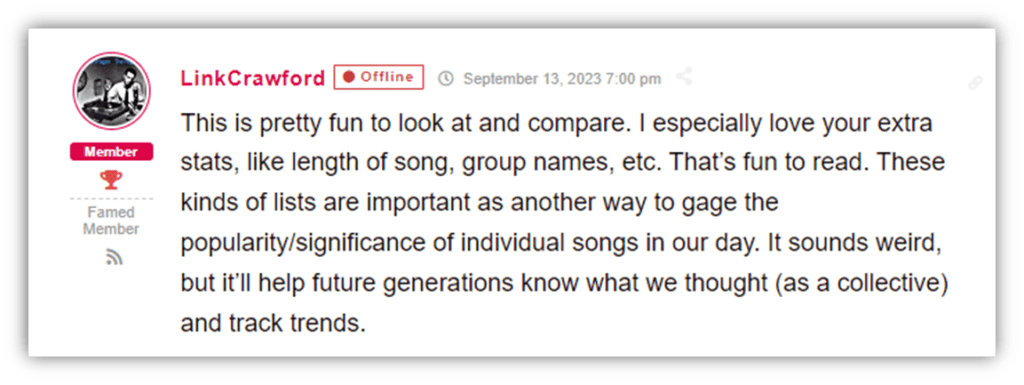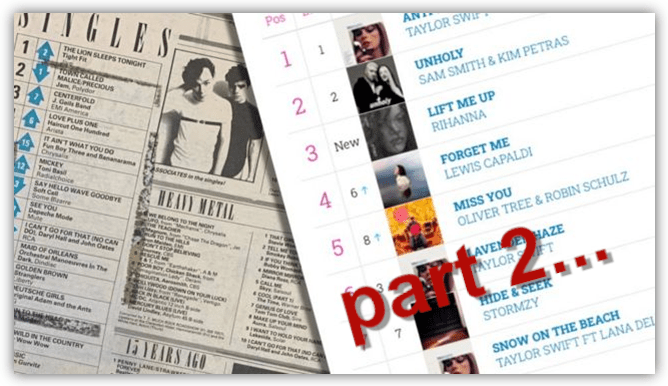We resume the story of the British charts…

…in 1977: in the wake of a revision of history that went largely under the radar at the time.
The year witnessed another, much more visible chart dispute. It was the Silver Jubilee, celebrating 25 years on the throne for Queen Elizabeth II.

The Sex Pistols had the perfect song for the occasion in God Save The Queen.
The official line is that in the week of the jubilee, GSTQ was at #2 behind Rod Stewart’s “I Don’t Want To Talk About It.”
For some, it’s held as fact that the charts were fixed to prevent the ignominy of youthful anger contradicting the pomp and circumstance.
One assertion is that BMRB changed the chart rules for that week, so that singles sold through the same label and store were invalid.

This would count against the Sex Pistols being signed to the Virgin label by discounting sales from Virgin stores.
Others that the panel of stores sampled that week were loaded in favour of High Street chains, rather than the independents, which buyers of GSTQ would favour. Especially as GSTQ was banned by many of the chains.
Its still disputed as to what actually happened. I’ve read ‘proof’ from both sides, and even found one person asserting that Kenny Rogers’ “Lucille,” which was #3 that week, and would follow Rod at #1 was already the biggest seller.

Chart manipulation was nothing new. It’s just that it normally comes from the record companies trying to game it to their advantage.
The stores on the chart panel were meant to be confidential.
But it wasn’t a well kept secret.
In the 60s and 70s teams of teenagers and housewives were sent out to buy up copies of singles and within stores employees falsified the numbers.

This didn’t impact the big sellers at the top end of the charts, but was intended to give a record a helping hand into the lower reaches of the top 40.
Which would provide increased exposure on radio and TV to further boost its fortunes.
In 1983 responsibility for the charts passed to Gallup.

They finally entered the modern age with a computerised reporting system. Having been extended to 75 places in 1978, it now reached 200 entries. Though: Positions 101 to 200 were only ever available to the industry and serious chart devotees via subscription to a newsletter licensing the data from the OCC.
To the uninitiated the range of numbers can be confusing. Regardless of how many places the full chart extends to, public perception is that being in the top 40 makes it a hit. Music Week (since 1972 the rebranded title of Record Retailer and since 1977 no longer owned by Billboard) publishes the top 75 which is the marker required to get into the British Book of Hit Singles. While these days, the top 100 is available through the OCC website.
The charts experienced many restructures over their first two decades.
But the one change to the physical single came early with the replacement of shellac 78s with vinyl 45s.
Things accelerated from the mid 70s.

12″ singles were introduced in 1976.
Although the format became associated with dance music, the first was from The Who: “Substitute”
The first picture disc to make the top 10:

1978’s The Cars: “My Best Friends Girl”
Cassette singles debuted in 1978. It’s widely reported that the aptly titled “C30 C60 C90 Go” by Bow Wow Wow was first in 1980, but punk band The Tights’ Howard Hughes got there first in ’78 .

It wasn’t ’til 1989 that cassette singles counted towards the charts.
The delay was due to their low retail price. They were finally made eligible as their increasing popularity meant that excluding them was impacting chart positions.

The CD single arrived in 1985 and counted towards the chart from 1987.
All these different formats encouraged sales, as completists needed to buy them all for the various B-sides, remixes, picture discs, etc. In order to offset fans being encouraged to buy numerous formats, the number that could count towards chart position was restricted to four in 1991.
One rule change in 1990 was necessitated by the closest ever battle for #1.

“The Joker” by Steve Miller Band was reissued for the background of a Levis ad…

… going head to head with “Groove Is In The Heart” by Deee-Lite.
They tied in sales – with “The Joker” named #1: Due to a rule that a tie would be resolved by the song with the biggest week-on-week increase taking the honours. The Joker rose from #6 compared to #4 for “Groove Is In The Heart.”
Rules is rules, despite the furore by disgruntled Deee-Lite fans. It turned out the tie was due to figures being rounded up in the convoluted sales recording process. Once the data was drilled into, “The Joker” had outsold GIITH:

By eight copies.
Right outcome – despite the wrong methodology.
This ruling on how to separate ties was done away with, to avoid a repeat.
Having beaten off competition from print publications a new challenger to the Radio 1 / Music Week chart arrived in 1983.
Known as the Network Chart, this was carried by regional commercial stations and broadcast every Sunday evening.

It adopted the Billboard approach of mixing sales and airplay but with an adaptation: The top 10 was entirely sales based, and 11 to 40 included the airplay element.
It went out on a Sunday evening, prompting Radio 1 to brings theirs forward from Tuesday to the same slot – so they were in direct competition. Over time, the Network Chart won in terms of higher listening figures, but never dislodged the more established version from being seen as the official chart.
Changes kept on coming:

In 1994: compiling the chart transferred from Gallup to Milward Brown. At this stage the sampling panel was at 1,000 retailers.
The mid 90s saw it become commonplace for singles to enter the chart at their highest position and gradually fall down the chart. Songs were released to radio weeks in advance of being physically available to create demand and a rush to purchase in the first week. Having been a rarity to enter at #1, it became the norm.
The digital age arrived in 2005 with downloads counting towards the single chart.
At first this was only for the week before physical release. But in 2007 this restriction was removed.

2014 saw streaming added to the mix with contortions needed to equate streams to sales and keep this new world in check.
100 streams on a premium account or 600 streams on an ad funded service equates to one sale.

Streaming saw all 16 tracks from Ed Sheeran’s “÷” appear in the top 20 of the singles chart.
Cue a new rule: restricting artists to a maximum of three singles in the top 100 at the same time.
2018 saw the introduction of Accelerated Chart Ratios to solve another streaming related issue of tracks sticking around longer.
ACR means that once a track has spent 10 weeks on the chart, if its streams decline for three successive weeks the number required to equal one sale doubles. Thereby accelerating their fall down the chart and making room for fresh blood.
It was also intended to keep the Christmas chart in check:

allowing for new music when streaming made it easier for the same golden oldies to dominate the chart every December.
ACR applies to any song over three years old. So those classics need to double the number of streams to compete with new tracks.
Which meant the Stranger Things inspired success of “Running Up That Hill” was caught by the rule.

Despite RUTH being streamed around 300,000 times a day more than Harry Styles’ “As It Was,” ACR pushed it down to #2.
This provoked mass calls through new and old media alike for Kate to get her due. It is in the small print that record labels can request ACR be suspended, which Kate’s label subsequently did- and RUTH ascended to the top spot for three weeks. The small print was conveniently overlooked as the media proclaimed victory in their crusade.
So where are we now?
There’s a trend for comment pieces, stating the charts have lost their relevance, and asking whether there is now any point to them.

Actual single sales are generally just a few thousand per week for even the most popular songs, and are mostly via iTunes or Amazon.
As such the contortions are necessary to find a balance so that new music isn’t washed away in the stream.
It might have been a whole lot simpler when the equation was just, “how many copies of a 7″ had been sold per week.”

As we’ve seen though, the multiple competing charts and paucity of data means that the reality was nowhere near as simple as the airbrushed history now makes out.
Ironically: the digital revolution in the 00s coincided with chart sampling finally reaching a point where sales from all retailers would be taken into account making the chart more accurate than it had ever been.

Counting against the charts is the fact that having regularly gotten 15 million viewers at its 1970s peak (albeit when there were only three TV channels) Top Of The Pops was canned in 2006.
(Other than for a once a year Christmas special, with viewing figures a fraction of what they had been.)
With no outlet on mainstream TV the visibility of the charts decreased.
On radio, listenership peaked in the 80s at around 4 million. By 2020 with the chart now broadcast in the Friday drivetime slot, reflecting a move to being compiled from Friday to Thursday, it was down to 1.4m listeners.

Meanwhile on Radio 2, “Pick Of The Pops” now delivering a weekly blast of nostalgia providing chart rundowns for the corresponding week from years past was pulling in 2.5m.
A fact some commentators take as proof that the charts have had their day and it was so much better in the past.
Or to look at it a different way: older generations are more likely to tune in to the actual show, whereas a younger generation are as likely to listen in after the fact. Evidenced by the chart show being one of the most popular downloads on the BBC Sounds app.
In the last year a study was carried out into their relevance:
The Official Chart – The ‘People’s Algorithm’

This found that 76% are still aware of the Official Charts while 69% said the charts are their favourite means of discovering new music. Putting them ahead of the likes of TikTok and YouTube.
And in case you’re thinking that it may skew lower for younger people: the new music percentage rises to 72% for under 25s. As ever, the devil is in the detail for these things, and I don’t know their methods for getting to these results… so who knows?
Link Crawford made a comment on the piece I wrote for the Rolling Stone Song Poll which also acts as a perfect summation of why the charts still matter:

There are so many competing forces taking attention away from the charts, and so many opportunities to delve into niche genres. But the charts still do a service in tracking and reflecting popularity.
As we age, many people will switch off from modern culture and lose track of the charts.
But there is still an audience out there – and fans and acts, for whom the validation of a big hit still means something.
Let the author know that you liked their article with a “Green Thumb” Upvote!





Great stuff as always, JJ,
I guess it would have been extra special if “C30 C60 C90 Go” had been the very first cassette single to be released, but thankfully this is the first time hearing about that belief, so I am spared the disappointment in learning a less magical truth.
I agree with you and Link that charts are interesting and important cultural artifacts for future generations to explore. I also agree with your take that the devil is in the details–and in this case it was probably various boards composed of stuffy, well dressed devils mucking things up with arbitrary and self-serving details.
Now that we’re in the era of streaming, I do wonder how useful the charts will be in their reflection of popular sentiment. It was always through a glass darkly, but the black mirror we’ve got now is darkest of all (except for the show, which should really stop its embarrassing descent and preserve its legacy!).
Wikipedia claims that C30/60/90 is the first cassingle. Can’t blame them as I found other sources saying the same but The Tights deserve their due!
Fun fact about “C30 C60 C90 Go,” the cassette single, or cassingle, had the A song and the B song on the same side of the tape. The other side was blank so you could use it to tape something else off the radio. This was excellent marketing for a song about music piracy.
Good stuff, JJ! I didn’t realize people still use the charts for music discovery. Guess I’ll have to start reading the charts again!
Not all of Malcolm McLaren’s ideas for gaining notoriety / publicity were quite so appealing but leaving one side of the cassette blank was a stroke of genius. I’m assuming he was behind it as their manager.
Precisely, and he’s credited as one of its songwriters, too.
As a UK chart watcher, this is riveting! The Pet Shop Boys were masterful chart manipulators, or at least I believe them to be unless you say differently. In the 90s and 00s, the Boys would release a song + multiple remixes that were included on 2 CDs. Other acts followed. I am wondering if both CDs/releases counted towards chart placings? Kate Bush also had a good strategy with the release of The Red Shoes (the song), with two separate CDs being released a week a part. I believe the song rose in its second week, which was rare as you mentioned most songs would debut at their peak position.
mt included Steve Wright’s picture on the Pick of the Pops logo, but I am still in mourning that Paul Gambaccini just ended his run as host. He is a Chart fanatic and I loved his rundown of the Top 20 from any given year. I also love his “Classic Warning”s! Sadly, I never got to hear Allan “Fluff” Freeman present POTP’s. I believe he originated the show, but I did hear him countdown The Network Chart on London’s Capital Radio in ’87. Cheers, for a stellar writeup!
Despite being a follower of Pet Shop Boys since the beginning I’ve never bought a single….err, single by them. Plenty of albums. I can’t verify their chart manipulating tactics but the method you describe was popular at that time. The 90s were my peak single buying years, I’d like to say I didn’t fall for the strategy of buying both versions of a single but there were occasions when I did it for my favourite bands.
The Boo Radley singles from the C’mon Kids album did exactly what you describe. Two CDs with the single backed by multiple entirely unnecessary remixes that barely warranted listening to once let alone repeat spins.
As a treat here’s a recording of ‘Fluff’ presenting Pick of the Pops in 1997 when he was 70. The music is mostly removed so it’s pure Alan, including all of his catchphrases; ‘pop pickers’, ‘alright’ and ‘not arf’ (arf as in half). If 12 minutes is too much for you just give the first and last couple of minutes a go for the essential experience. If you detect a twang in his voice its because he’s actually Australian, moved to Britain in the 50s. And the reason he’s known as Fluff is due to a fluffy jumper he used to wear.
Alright pop pickers? Not arf.
https://youtu.be/gMG6ZgNoilk?feature=shared
Hmm, wrote up a reply and saved it, realised I’d forgotten to add the link. Went back into edit the comment and got a message that it was potential spam and swiftly removed the comment.
Let’s try again. Despite being a big PSB fan I never bought any actual singles, only albums. I can’t verify their chart manipulation methods but the strategy you describe was very popular. The 90s were my peak single buying period and I’d like to say I didn’t fall for tactic of buying the same song twice but backed with multiple remixes but I did on occasion do it for my favourite bands.
The singles from The Boo Radleys; C’mon Kids album adhered to this and I bought them all. Which meant that for the 3 singles released I bought 6 CDs. All with numerous unnecessary remixes that barely warranted one listen let alone repeat spins.
For a treat here’s a recording of Fluff from 1997 when he was 70. The music is mostly removed so it’s pure Alan babbling away for 12 minutes. If that’s too much just listen to the first 2 and last 2 minutes for the intro and chart rundown and you get all his catchphrases and vocal mannerisms. If you detect a twang in his voice its cos he’s actually Australian. He came to Britain in the 50s when he was already nearly 30. And the reason he’s called Fluff is due to a fluffy jumper he wore.
https://youtu.be/gMG6ZgNoilk?feature=shared
Cheers for the Fluff Freeman link; he exuded so much energy and enjoyment when he counted down the charts. Did not know he was from Oz or the origin of his stage name.
The Boo’s RULE. Just got my copy of Giant Steps on vinyl. C’mon Kids is also engaging and out there in a good way.
Giant Steps and C’mon Kids are two of my fsvourite albums, both wildly inventive and out there but to me they reflect opposite perspectives. GS represents the excitement that anything is possible whereas CK is the success isn’t all its cracked up to be come down.
Here in the States I was familiar with Gambaccini first as a contributor to Rolling Stone and then as one of the principles behind the series of books about No. 1 UK hits. Glad to hear his name mentioned here and sorry that he has ended his run on a radio show there.
And totally awesome job on this, JJ!
Gambo LIVES! He has a new weekly show on BBC Radio 2: The Paul Gambaccini Collection. I listened to a tribute show for him hosted by Steve Wright with Gambo right there with him talking about his storied career in radio. The Rolling Stone writing gig was mentioned and how Gambo interviewed Elton John (helping to break him in the US) and McCartney. I rember listening to Gambo count down the Top 20 classical LPs on the newly launched (at the time) Classic FM. That broke the Gorecki III symphony. If I had to chose a fantasy career, it would have been Paul Gambaccini’s. In the Top 3 for my fave DJ’s – Casey Kasem and Annie Nightingale would be the others. Cheers. https://www.bbc.co.uk/sounds/play/m001rp9m
How did your brain not explode after researching all that, JJ? Honestly, I feel like a Gumby right now – “My brain hurts!”
Kudos to you on writing all that up JJ, lots to mull on here….
It seemed so easy at first. By the time I’d spent several hours reading online forums digging into the minutiae of chart compilation and a detailed account of why Kenny Rogers was really #1 and not Rod or the Sex Pistols it was too late to turn back.
If I’ve missed anything or got anything wrong I can only apologise to the real chart enthusiasts. There was a lot of information and at times contradictory accounts but I’ve done my best to give a good account.
In the preamble on the front page, I referred to JJ as a” Contributing Author and Registered Diagraphophile.”
Speaking for myself, I’ve been this way for as long as I can remember. I think most of us like to watch the charts. Before Billboard magazine was more fan driven and more of an industry trade paper, I would special order it at the exorbitant price of three dollars a copy from the local news stand. I would study it like it was a SAT prep.
For whatever reason, I still get a kick out of it. Even for songs that I don’t particularly care about, I imagine vicariously, the thrill of the artist seeing their entry on the hot 100, official charts, et al.. must be amazing.
I have no business at my age following pop, music, and while I don’t study and listen to it as much as I did before, I will stop in my tracks anytime I get a glimpse of a chart. Be it a 50-year-old re-print, or a digital webpage of this week’s Top of the pops, it still fascinates, satisfies, and is something that I enjoy.
Can’t explain it. But it’s been nothing but fun for me.
Let me introduce you to a little column that explores one man’s joys, heartbreaks, opinions, and math behind all the songs that reached no. 1…
I had to look up what a diagraphophile is. Which suggests I don’t have my registration papers just yet. Now I know though, I’ll be submitting my application.
Totally get the buzz of following the charts. Music Week wasn’t widely available as it was more of an industry publication than for mass consumption. There was one local newsagent that carried it, I used to go in each week to flick through and take in the full single and album top 75. Never once bought it but I was an avid reader.
The height of irony: Rod’s song blocking the Sex Pistols. Clearly, the establishment did not want to have that conversation.
Great info, JJ! I’m particularly fond of the term ‘The People’s Algorithm.’ It seems an apt descriptor for the times.
Sometimes you can’t see the wood for the trees. Or rather I was too invested in the story to recognise the opportunity. Reading it through this morning when it went live I spotted the irony in I Don’t Want To Talk About It and the alleged cover up. Too late. Glad to see you were more on the ball.